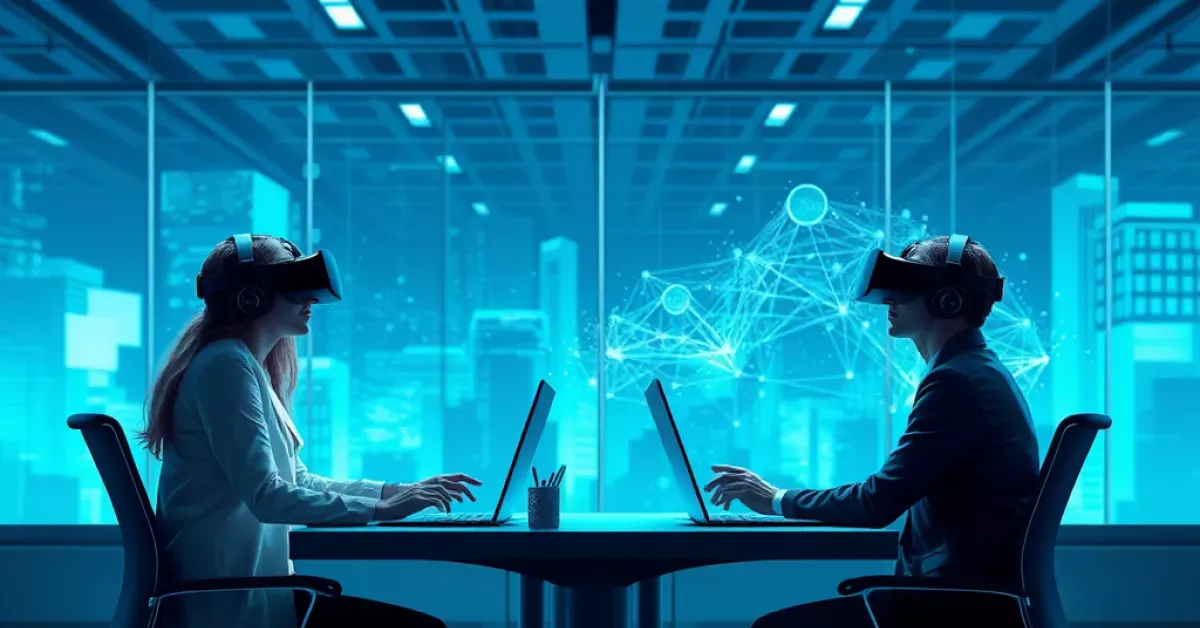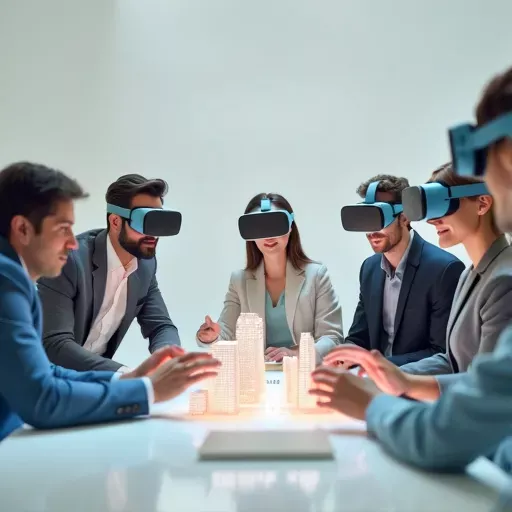It seems like we’re living in a science fiction movie, doesn’t it? From chatbots to self-driving cars, technology is reshaping our lives significantly. One of the latest stars in the tech world is virtual reality workspaces. No longer just the realm of video games, virtual reality (VR) is now part of our everyday working lives. This article will explore how VR is changing the face of workspaces everywhere, especially in Australia.

Understanding the Surge in Virtual Reality Workspaces
From Sci-Fi to Reality: How VR Became Mainstream
Not too long ago, virtual reality seemed something of science fiction movies or high-tech laboratories. Fast forward to today, it’s possible to attend a meeting halfway across the world in a VR setup without leaving your home. The technology has become mainstream thanks to powerful computers, better internet connections, and innovative minds that turned ideas into reality. What was once a dream is now at our fingertips, making work both more exciting and accessible.
The Role of VR in the Digital Transformation Journey
So, why is there all this fuss about VR in workspaces? Well, VR plays a vital role in the digital transformation journey many companies are undergoing. As businesses strive to become more digital and tech-savvy, VR offers them new ways to connect, collaborate, and innovate. Whether it’s training sessions or international meetings, VR is helping businesses run more efficiently.
Why Businesses Are Embracing VR Workspaces
Businesses are embracing virtual reality workspaces because it allows for more flexible work arrangements. Imagine this: You wake up in the morning and instead of a dreary commute, you slip on a VR headset and instantly you’re at your office desk surrounded by your colleagues in a virtual space. Companies find this setup saves travel costs, reduces time spent commuting, and can increase job satisfaction among employees.
The Nuts and Bolts of VR Equipment for the Office
Essential VR Gear for Peak Productivity
To get started with VR in the workplace, you’ll need the right equipment. VR headsets are at the heart of any virtual reality experience. These devices create the illusion of a virtual world. Some popular options include the Oculus Rift and the HTC Vive. Along with the headset, you’ll need compatible controllers to interact with the virtual environment. A powerful computer helps ensure everything runs smoothly without hiccups, making your virtual office as effective as a real one.
Streamlining Tech Integration in the Modern Office
Getting the right tech is one thing, but integrating it smoothly into the office is another. Companies often work with IT specialists to install VR systems that align with their work processes. It’s important to make sure that the tech integration is seamless so employees can use VR equipment without much fuss. Training sessions help employees get the hang of the new tools, and before long, the advanced systems feel just as routine as sending an email.
Enhancing Productivity Through Immersive Technology
The New Frontier of Remote Work and Ergonomics
One great aspect of VR is its potential to improve ergonomics and remote work. Employees who work from home can avoid the physical strain that traditional office setups might cause thanks to VR’s flexible options for comfort and environment. Imagine designing your work desk in a virtual forest or by a beach, where your posture is perfect and you’re more relaxed. This new frontier is proving that it is possible to balance productivity with wellbeing.
Boosting Efficiency: The Impact of VR on Telecommuting
Telecommuting has taken on a whole new meaning with VR. Through immersive technology, employees can work from anywhere while feeling just as connected as if they were in a physical office. Daily tasks, brainstorming sessions, and even casual chit-chats become part of the virtual office life. This connectivity can boost team morale and efficiency, making telecommuting more productive and enjoyable.
VR and the Future of Work: What to Expect
As VR technology continues to improve, it will likely play an increasingly important role in our work life. We can expect more companies to adopt VR not just for meetings, but for roles like training and onboarding new employees, or even virtual site inspections. The future of work will involve more dynamic and interactive virtual experiences, merging the physical and digital worlds seamlessly.
Digital Transformation and the Evolution of Workspaces

A glimpse into the future of work, where productivity meets relaxation in virtual settings.
Digital Transformation and the Evolution of Workspaces
How Collaboration Tools are Adapting to VR
Businesses aren’t just bringing VR into their workspaces; they’re also adapting existing technologies to support it. Collaboration tools that used to be limited to video calls and chats are now integrating with VR to support immersive meetings. Software like Zoom, Microsoft Teams, and Slack are continuously evolving to seamlessly integrate VR elements, making interaction in virtual spaces more efficient.
Exploring the Workplace Evolution with VR
The concept of what the workplace looks like is evolving alongside VR technology. The workplace evolution involves rethinking how businesses use space. With fewer people needing physical desks, offices might become smaller or more flexible. This could lead to more shared spaces and creative environments, not just for work but for social interaction too—as companies explore this exciting new territory, VR offers endless possibilities.
Remote Teams and Workplace Flexibility in the VR Era
Navigating User Experience in Virtual Settings
Creating a smooth user experience in virtual reality settings is key for VR workspaces to truly benefit employees. Companies focus on making the user experience intuitive and comfortable. When done right, employees feel less overwhelmed by tech and more focused on tasks. Finding the right balance helps team members from different parts of the globe collaborate as if they were sitting in the same room.
Building Effective Remote Teams with VR
With VR, remote teams can come together in ways that weren’t possible before. Imagine doing a project with someone from another continent and being able to walk through a 3D model together. Effective remote teams are built on good communication and VR allows just that—making it easier to understand each other’s ideas. It adds a layer of personal interaction, essential for maintaining team spirit even in different time zones.
Tech Innovation and Advancements in VR Workspaces

Harnessing virtual reality for enhanced remote teamwork and collaboration.
Tech Innovation and Advancements in VR Workspaces
Breaking Down the Latest Tech Trends and Innovations
As we venture further into the world of VR, tech innovations continue to emerge at an exciting pace. Right now, advancements such as more lifelike avatars, improved graphics, and better haptic feedback are making VR workspaces feel more realistic and engaging. These trends not only enhance the virtual environment but also make businesses more inclined to utilise VR technology.
The Interplay of Business Strategies and VR
Businesses are incorporating VR not just as a tool but as part of broader strategies to innovate and grow. By weaving VR into their business strategies, companies are finding new ways to optimise operations and engage with both employees and customers. It’s a journey that ties innovation with strategy, allowing businesses to achieve goals that might have appeared unreachable in the past.
Real World Applications: Business Stories and Successes
Case Studies: Real-World Uses of VR in the Office
There are many success stories of businesses using VR in real world applications. For instance, some architecture firms use VR to let clients “walk through” designs before any construction begins, reducing misunderstandings and improving client satisfaction. Case studies like these show that VR is not just a passing trend but a valuable tool across industries including education, healthcare, and retail.
Overcoming Challenges and Maximising Benefits
Of course, implementing VR isn’t without its challenges. Balancing costs, ensuring data security, and managing user tech skills are just a few hurdles. However, many businesses find that the benefits outweigh these challenges. By investing in VR, companies can enjoy increased collaboration, innovation, and productivity. The goal is to maximise benefits while strategically overcoming any setbacks.
Preparing for the Future: Adapting to VR Workspaces
Building a VR-ready Business Strategy
Adapting to VR workspaces involves careful planning and strategy. Building a VR-ready business strategy means assessing your company’s current needs and future goals, aligning them with what VR technology can offer. It’s about understanding the tech scene and making informed decisions to integrate VR organically without disrupting the flow of daily operations.
Embracing Change: A New Era in Workplace Technology
As VR continues to gain traction in workplaces, it heralds a new era in workplace technology. To keep pace with this change, businesses need to be open to new ideas and flexible enough to adapt. It’s all about embracing change and seeing it as an opportunity rather than a hurdle. In this new era, those willing to explore VR’s full potential will likely find themselves at the forefront of innovation and success.
As we look towards the future, virtual reality workspaces promise to redefine how we understand our working environments. For businesses across Australia and beyond, it’s an exciting time to explore how we connect, create, and interact—all thanks to the wonders of VR.
I’m an IT guy with eclectic interests. Computers, web development, science, technology, travel, adventure, people, world affairs, philosophy, spirituality. On top of all that, I like to have a beer 😉